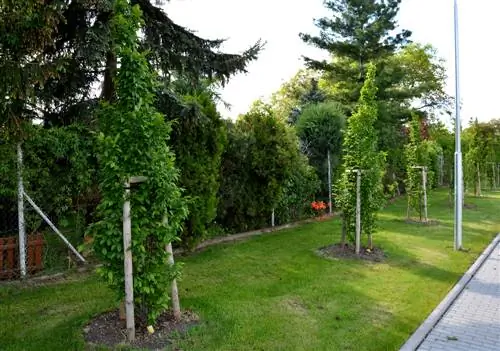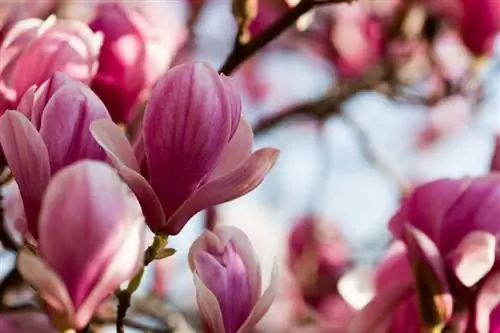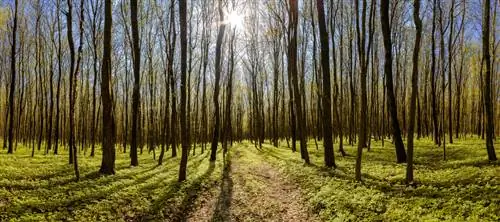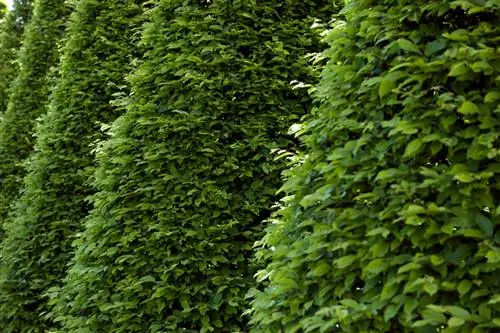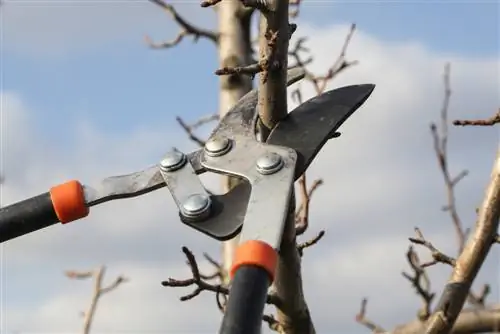- Author admin [email protected].
- Public 2023-12-16 16:46.
- Last modified 2025-01-23 11:22.
Read everything you need to know about the columnar hornbeam as a standard tree or shrub in the commented profile here. This is how you plant, care for and cut Carpinus betulus Fastigiata correctly.

What is the columnar hornbeam and how is it used?
The columnar hornbeam (Carpinus betulus Fastigiata) is a hardy, columnar deciduous tree and belongs to the birch family. It reaches a height of 10 to 20 m and a growth width of 4 to 6 m, with ovoid, sawn foliage and hanging catkin flowers. It is used as a house tree, hedge or container plant.
Profile
- Scientific name: Carpinus betulus Fastigiata
- Family: Birch family (Betulaceae)
- Genus: Hornbeams (Carpinus)
- Synonyms: columnar hornbeam, pyramidal hornbeam
- Growth type: deciduous tree
- Growth height: 10 m to 20 m
- Growth width: 4 m to 6 m
- Leaf: egg-shaped, serrate
- Flower: Kitten
- Fruit: winged nut
- Winter hardiness: hardy
- Use: house tree, hedge, potted plant
Growth
With its shapely growth, the columnar hornbeam gives the garden an architectural component. The hornbeam column owes its elegant silhouette to expert refinement in the tree nursery. These properties make Carpinus betulus Fastigiata a highlight worth seeing in creative garden design:
- Growth form: columnar to pyramidal, later broadly ovoid to spreading spherical.
- Growth height: 10 m to 20 m
- Growth width: 4 m to 6 m
- Annual growth: 20 cm to 40 cm
Over the years, the ravages of time eat away at the pyramidal-column-shaped growth. The vertically oriented branches gradually bend horizontally. An egg-shaped crown forms with broad, spreading branches in the lower area and tightly upright branches in the upper area.
Leaf
Its slender shape dresses the columnar hornbeam in a decorative foliage robe with these features:
- Leaf shape: egg-shaped, pointed, rounded at the base to heart-shaped or crooked
- Special feature: double-serrated leaf edge, distinctive pairs of leaf veins
- Leaf size: 4 cm to 10 cm long, 2 cm to 5 cm wide
- Leaf color: dark green, yellow autumn color
- Arrangement: alternate
A characteristic feature of every hornbeam is that the summer green leaves stay on the tree almost all year round. Following the autumn color, the leaves turn brown and remain persistently attached to the branches until the next shoot.
Bloom
In the previous year, the pyramid hornbeam produces its flowers on young shoots, which overwinter as buds. The inflorescence is familiar to us from many local birch plants, such as the picturesque silver birch. These attributes characterize the flower of a columnar hornbeam:
- Flower ecology: monoecious, separate sexes
- Flowering time: April and May
- Male flowers: 4 cm to 6 cm long, hanging, yellowish-green catkins
- Female flowers: 2 cm to 4 cm large catkins, initially upright, later hanging
- Pollination: Wind
Columnar hornbeams are grafted onto a robust and weakly growing base. This means that the trees are more lazy to flower than the original species Carpinus betulus.
Usage
Numerous advantages recommend planting columnar hornbeams in the garden. The trees are hardy, undemanding, easy to care for, particularly easy to cut and very decorative. This results in a colorful array of creative uses:
| High trunk | Shrub |
|---|---|
| Solitaire | Privacy hedge |
| Avenue tree | Bed border |
| Group | potted plant |
| Bonsai | Balcony privacy screen |
| Bucket | Topiary tree |
Thanks to their good-natured pruning tolerance, Carpinus betulus Fastigiata are among the most popular hedge plants for small and large gardens. Let the tips in the following video inspire you for creative design ideas:
Video: Using columnar hornbeam as a hedge - tips
Planting columnar hornbeam
The nursery offers refined hornbeam columns in pots or bales all year round. As long as the garden soil is not frozen or dried out, the trees can be planted in the bed without any concerns. The ideal time window for planting in a container opens in April. Where and how to properly plant a columnar hornbeam can be found in the following sections:
Location
When it comes to choosing a location, the columnar hornbeam is undemanding and modest. Normal garden soil with acceptable lighting conditions satisfies the native deciduous trees. A hornbeam column achieves optimal growth performance at this location:
- Sunny to partially shaded.
- Nutritious, humus-rich soil, preferably containing clay.
- Fresh to moist and well-drained.
- Exclusion criteria: acidic pH value less than 5, long-lasting waterlogging.
In a shady location, a columnar hornbeam doesn't go limp. However, due to the lack of light, the foliage is loose and patchy.
Planting columnar hornbeam standard tree
As a standard tree, the columnar hornbeam is a heavyweight. Working as a team, you can complete the planting without causing any injuries to the gardener or the tree. These tips get to the heart of everything important:
- The planting pit is twice as big as the root ball.
- As starting fertilizer, one third of the excavation is enriched with compost and horn shavings.
- The distance to the property line corresponds to the legal requirements (usually at least 2 m).
- A support pole protects the standard tree from windthrow.
- The planting depth corresponds to the planting depth in the tree nursery (note the earth mark on the trunk).
Tamp the bed soil firmly. Ideally, you should form a casting ring around the tree disc. Generously slurry the newly planted tree.
Planting a columnar hornbeam hedge
The best time to plant a hedge of columnar hornbeams is in autumn. To ensure that the hedge runs straight, string up ropes for orientation. You adjust the correct planting distance to the planned growth height and width. To create a complete privacy hedge, plant three trees per meter.
Planting columnar hornbeam in a pot
Decoratively, the columnar hornbeam in the pot is presented as a green reception committee at the entrance to the house or as a sleek privacy screen on the balcony and terrace. This is what you need to consider when planting Carpinus betulus Fastigiata in a pot:
- Substrate: nutrient-rich potted plant soil without peat, optimized with coconut fibers and lava granules.
- Pot size: two to three fingers fit between the root ball and the edge of the pot.
- Important: There are several holes in the bottom of the bucket for water drainage.
- Drainage: a 5 cm high layer of expanded clay, pottery shards or chippings.
- Planting depth: plant as deep as before, with a 3 cm to 5 cm high distance from the edge of the container as a watering edge.
Please water thoroughly until the water runs out from under the bucket. Pour away any water that has accumulated in the saucer after 10 minutes to prevent waterlogging.
Excursus
High trunk, heister or shrub - differences
In the tree nursery you can buy Carpinus betulus Fastigiata refined as a standard tree, heister or shrub. These are the most important differences: On the standard trunk, the branching to the crown begins at a trunk height of 200 cm. A central central shoot with side branches from the base to the tip is typical for the Heister. A shrub has no leading shoot and is much more compact than a heister.
Care for columnar hornbeam
The columnar hornbeam is very easy to care for. Watering when necessary and initial fertilization keep the noble hornbeam happy. The extent to which you practice pruning care depends on your horticultural decision. Please read these useful care tips:
Pouring
Water a planted columnar hornbeam with normal tap water when the garden soil is noticeably dry. In the pot in a sunny location, the deciduous tree often requires a good drink of water. Ideally, on hot summer days, you should pay your hornbeam column a daily visit with a watering can.
Fertilize
You can get growth going with starter fertilization in March or April. Distribute 3 liters of mature compost soil and 100 grams of horn shavings on the root disc. Rake in the organic fertilizer and water again. From March to September, apply a liquid fertilizer (€6.00 on Amazon) for green plants in the bucket every month.
Cutting
The columnar hornbeam is just as compatible with pruning as the pure variety. Fortunately, a refined hornbeam develops its columnar stature without regular pruning. As a hedge or topiary, scheduled pruning care guarantees dense, compact growth within the desired framework. The following table provides an insight into common cutting options:
| Growth type | Cut style | Goal/Occasion | best time |
|---|---|---|---|
| High trunk | Form and maintenance cut | Shaping the crown, regulating expansion | End of January to end of February |
| High trunk | Blending cut | Removing dead wood | every 4 years in late winter |
| High trunk | Rejuvenation cut | revitalize aging crown | November to February |
| Solitary Shrub | Topiary | Shape cylinder, cone, sculpture | February and June |
| Hedge | Shaping, care cut | opaque, well-groomed growth | February and June |
| Shrub/Hedge | Rejuvenation cut | rebuilding old bushes | November to February |
As you can read in the profile, the columnar hornbeam produces its flower buds the previous year. As a result, every pruning reduces the number of catkin flowers, much to the chagrin of wild bees.
Popular varieties
If the majestic Carpinus betulus Fastigiata is too big for your garden, it is worth taking a look at other refined hornbeam columns from the nursery with growth suitable for the garden:
- Lucas: new, slow-growing columnar hornbeam, pyramidal, densely leafed, 4-5 m high after 10 years.
- Monument: weak-growing, narrow variety, perfect for hedge planting, growth height 4-6 m, growth width 1.5 m.
- Frans Fontaine: tightly upright when young, later very dense, narrow-ovoid crown, height 6-10 m.
- Columnaris: fresh green foliage, elegantly columnar, growth height 8-12 m, growth width 6-10 m, beautiful in the pot.
FAQ
When does the crown of the Carpinus betulus standard tree reach two meters in diameter?
It takes a good 10 years for the crown of a columnar hornbeam to reach a diameter of 2 meters as a standard tree. You can speed up the process with annual pruning care. Every late winter, cut all shoots back slightly to an outward-facing bud.
Is the columnar hornbeam suitable as a potted plant with a privacy function?
Columnar hornbeams can easily be kept in the pot for many years. It is important to note that you repot the trees every two to three years in a larger pot with fresh soil. Regular watering and fertilizing ensure rapid growth at privacy height. In the nursery you can get columnar hornbeams as hedge elements with a height of 100 cm to 150 cm, which you can grow to 200 cm or higher.
Can I permanently keep a hornbeam as a column at 1.20 m high and 40 cm wide?
Columnar hornbeams are very tolerant of pruning. To achieve the desired dimensions, cut the plant back twice a year. Carry out the main cut at the end of February on a frost-free day. At the end of June around St. Johanni, cut back this year's growth.
How do you branch a columnar hornbeam to the standard trunk?
Select the strongest shoot on a young plant as the future trunk. You raise this leading shoot upwards, ideally with a support post. Over the years, cut off the thickest side shoots directly on the trunk. If the leading shoot has reached a height of 2.20 to 2.50 meters, cut off the top. The columnar hornbeam then branches out at this point to form a standard trunk with a crown.

